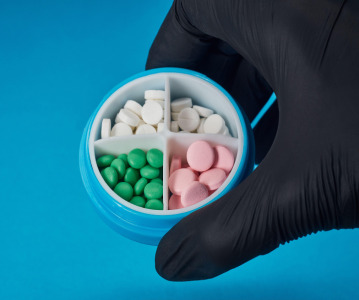Continuous manufacturing: CDMOs have a huge role to play in helping deliver wider adoption

During CPHI Discover (17th-28th May, 2021) – global pharma’s largest ever virtual gathering – we spoke with Doug Hausner, Senior Manager Continuous Manufacturing at Thermo Fisher Scientific. He presented his views on how continuous manufacturing is still at the start of its adaption curve in the industry, and what lies ahead as expertise transfers from a handful of pharma companies to first mover CDMOs. Looking ahead, Hausner outlines the business case, the regulatory considerations and the role CDMOs can potentially play in helping biotech customers consider continuous approaches for new products.
CPHI Discover: Can we start by asking a contentious question – what is the definition of a continuous process?
Hausner: The definition established by regulators is that essentially a continuous process is any process where material continually enters and leaves the system at the same rate or close to the same rate. So it’s broad, and that enables it to capture as many things as possible under the continuous banner – which I do think is good, as these things are, case by case.
But if you zoom out far enough and think about it, you could look at an entire facility as being a continuous process, and there are some batch facilities that operate very efficiently and could try to fit that definition, so I think it really depends on the scale of scrutiny in terms of how you look at these things. But typically, when we talk about a continuous process, we’re referring to a process in which all the steps involved are continuous and it’s integrated.
To add a little further complexity, in terms of hybrid systems, there are a lot of things that fall in between batch and what we might think of as continuous, and these are semi-continuous systems. For example – and you don't see it as much anymore – some of the early lines may have had a batch blender in the middle of them or two of them, and they're kind of working in sequence in order to enable it to be a continuous process.
CPHI Discover: How far down the journey are we? We have been speaking about the technology for nearly a decade, but there are so many few commercial processes.
Hausner: Yes, this is a point that I get back to all the time. It is a very slow adoption curve and again, part of this is that the technology is not enabling a different product that people would otherwise make. So, when something new comes in the market, like you see with some of the new large molecule therapies, it is more likely that companies build new infrastructure, as otherwise they wouldn't be able to advance. Conversely, the challenge for continuous has been that it provides efficiencies, provides greater quality, and we can go through the whole list of things that it provides. But, at the end of the day, it's still going to be able to make you the same product that you should be able to make in batch.
The other piece that is starting to change - in part due to CDMOs like mine (Thermo Fisher) - was the business case, certainly in terms of the upfront investment and the traditional way of doing that where it's linked to a specific product. But often, continuous on a single product business case may not be viable.
Excitingly, however, when you talk about something that's more of a platform technology, it certainly becomes easier.
The other part that goes along with this is that it takes time and other resources: the personnel and having the people within your organisation that understand how to do the process development, and understanding how to handle this from a regulatory perspective.
CPHI Discover: Is continuous manufacturing more suitable for API or finished dose or both?
Hausner: I would say it has more applications in finished dose manufacturing, as here it's relatively straightforward for the same platform to be used for a lot of different products. The challenge with using it in API manufacturing is that for each product, there are often a number of different steps, with greater variance in methodology between products. This means you will probably need to reconfigure the line from product to product, so it may be a little bit more challenging.
What it does enable for APIs is alternative chemistries that you can't necessarily achieve in batch mode – e.g. for a dangerous reaction. So, in my organisation, we consider continuous manufacturing to be a tool in the toolbox for API manufacturing, but for finished product we see it as a platform technology and that is where we can see the most transformative uses.
CPHI Discover: When is the most appropriate time to consider continuous manufacturing in drug development?
Hausner: It’s a discussion that needs to start by Phase 2, with a target for Phase 3 clinical manufacturing using continuous to go into the commercial filing, as this is where you won't have any scaleup after that point. So, the rate limiting step becomes the filing and the approval and other aspects in terms of turning on your commercial engine because once the process has been developed on the line, it's ready to go commercial the next day.
CPHI Discover: What could accelerate adoption at CDMOs? Do we need Big Pharma support to get started?
Hausner: Well, what I would say is that that's kind of what's happening. If you look at my organisation, most of whom we’re working with at this point in time are Big Pharma. Big Pharma that has had internal CM programmes understand the technology. They understand what is needed and feel more comfortable with programmes that utilise it. But for smaller clients, there is more hesitancy and CDMO experience is going to come into play, they need to trust the CDMO can guide them through.
CPHI Discover: So, what advice would you give to perhaps a customer, an innovator less experienced, a small Pharma or Biotech?
Hausner: I guess one piece of advice would be come and talk to us and learn what is being offered before you have an imminent need. The problem is that sometimes, the innovator wants to look at continuous, but it's fairly late in the game and so if they're already in Phase 3 and are ready to go to commercial, it’s going to be very difficult to re-examine the process without affecting the product’s launch.
So, it's good to learn early about what is being offered as well as the team’s experience and the regulatory support that can be offered.
Clients often have a number of things in the pipeline and I've heard clients say, “we know we're going to be doing continuous in the future, the question is when?” so the question is, is this the right product? is this the right time? Is this the right investment for me to make, given where my organisation is and what I need to do commercially? So there are a lot of factors that go into it.
In terms of what could accelerate adoption at CDMOs, I think it's if we can demonstrate the commercial capability and viability. So, for example, right now we’re working with a number of clients that have products in Phase 3. Once they get to the commercial stage, I think that will really help to allow other people to say, “okay, this is a technology that I can use without having to make the upfront investment by working with a CDMO.” So, CDMOs that have demonstrated that they can work with other customers and take them through the process from early-stage development all the way through to filing and commercial manufacturing will enable further adoption. We have a large role to play in the next few years in helping deliver much wider adoption.
Related News
-
News Pharmapack Awards 2024 Patient-Centric Design Award Winner – Dr Ferrer BioPharma
The 2024 Pharmapack Awards celebrated the best in innovation and design for the pharmaceutical packaging and drug delivery industry on January 24, 2024. -
News Pharmapack Awards 2024 - Celebrating Packaging and Drug Delivery Innovation
The 2024 Pharmapack Innovation Awards ceremony celebrated the best in pharmaceutical packaging and drug delivery innovation at all levels. The awards were held on January 24, 2024 at the Paris Expo Porte de Versailles. -
News Women in Pharma: Looking back on 2023 and moving forward to 2024
In this monthly series, we interview women from across the pharmaceutical industry and supply chain to discuss the importance of gender diversity in healthcare, the workplace, and beyond. -
News On track at CPHI Barcelona - The Track Sponsor interview: USP
In our packed out content sessions at CPHI Barcelona this year we focus on some of the hottest topics coming up in the pharma industry, with each track sponsored by a leading expert in the field. -
News Women in Pharma: Marketing for the other half in healthcare
In our new monthly series, we interview women from across the pharmaceutical industry and supply chain to discuss the importance of gender diversity in healthcare, the workplace, and beyond. This instalment highlights not only the importance of ma... -
News Bringing the pharmaceutical supply chain closer to home
The pharmaceutical supply chain has encountered numerous disruptions in the last few years, impacting procurement, manufacturing, packaging, and distribution operations within the pharmaceutical industry. Read about the rise in calls for near/resh... -
News Delivering on mRNA-based therapeutics: innovations in applications and packaging
Since the onset of the COVID-19 pandemic, the innovative potential of mRNA vaccines and therapeutics has raised questions regarding their manufacturing, packaging, and storage/transportation. Learn about how the pharmaceutical supply chain is meet... -
News Your Prescription for Marketing Success: Digital Pharma Marketing Toolkit – Free eBook
Download your FREE pharma marketing eBook to learn why it is so important for pharmaceutical marketeers to develop their digital content marketing strategies in order to establish their companies as thought leaders and industry experts.
Position your company at the heart of the global Pharma industry with a CPHI Online membership
-
Your products and solutions visible to thousands of visitors within the largest Pharma marketplace
-
Generate high-quality, engaged leads for your business, all year round
-
Promote your business as the industry’s thought-leader by hosting your reports, brochures and videos within your profile
-
Your company’s profile boosted at all participating CPHI events
-
An easy-to-use platform with a detailed dashboard showing your leads and performance







